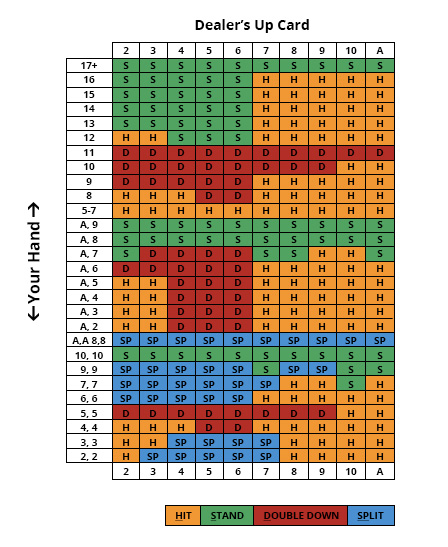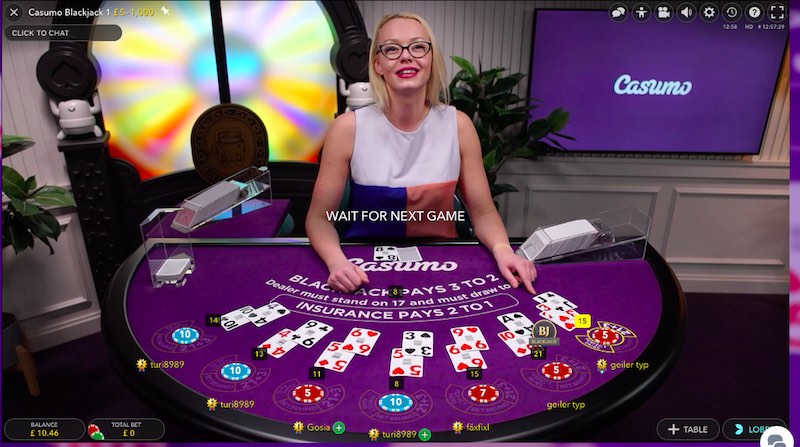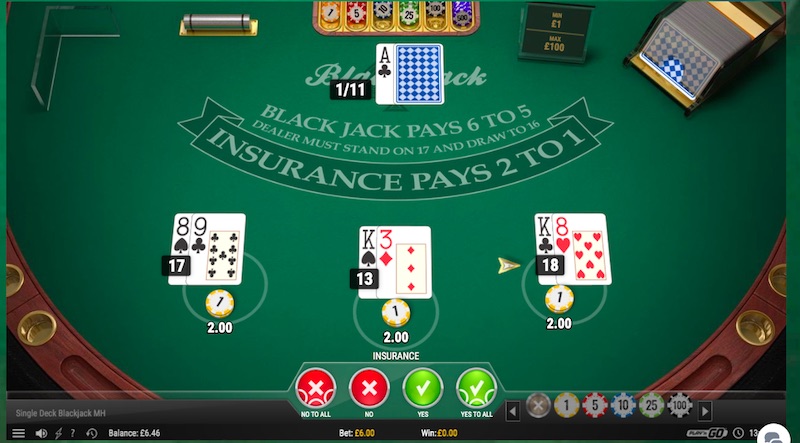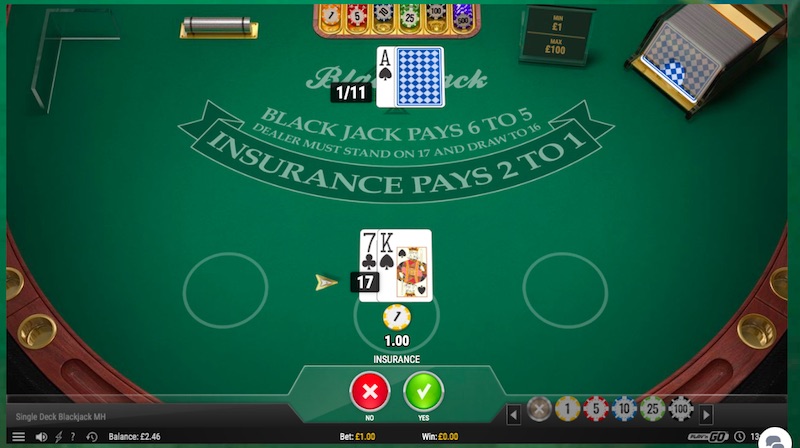This is a simple guide to playing Blackjack.
If you want the quick take away from this page, you can can use the Blackjack Strategy Chart shown here to determine which action to take dependent on your hand and the dealers hand. For more information about the rules of the game, and the reasons why you should Hit, Stand, Split or Double Down, including a quick lesson in probability, read on.
 An Introduction To Blackjack
An Introduction To Blackjack
The beauty of blackjack is that it’s a simple casino game to play. So long as you understand the key principle, to get closer to 21 than the dealer, you can then improve your chances of winning by following a simple blackjack strategy.
Unlike other popular casino games like roulette or baccarat, where you cannot affect the outcome of each round after your initial bet, in blackjack, you take a series of decisions which will help determine what happens. It’s, therefore, more of a skill game. You can choose to:
- Stand, taking no more cards
- Hit, receiving a further card (as many times as you like)
- Double down, doubling your initial bet
- Split, splitting a pair and playing with two hands
All these actions will contribute to the outcome of the hand. But before we explain in a little more detail how your simple blackjack strategy will make you a better player, we should outline the concept of the game.
And by the way, once you’ve read our guide and determined what your strategy will be you can find a site to play at on our Live Casinos page.

Live Multiplayer Blackjack at Casumo
What is blackjack?
Here are the basic rules to the game of Blackjack.
Blackjack, sometimes referred to as 21 or pontoon, is a game you play against the dealer. Once you place your bet (the amount will depend on the table limit), you receive two cards face-up. The dealer also gets two cards, revealing one.
Picture cards are worth ten, and aces can be 11 or 1. The idea is for the total value of your cards to be higher than the dealer’s, but without going over 21, in which case you bust and lose your bet.
Depending on the value of your first two cards, you can elect to hit and take another one, a move you can make multiple times, or stand and sit tight (we’ll explain doubling down and splitting later).
If you stand on 21 or less, the dealer then plays out the house hand. In most games you’ll play, the dealer must stand on 17 or more. You win if your total is higher than the dealer, or if the dealer busts, in which case your stake is returned, and the house matches it.
If you make a blackjack, when your two cards are an ace and a value ten, you hit 21 straight away and get paid more – a 3:2 return.
It’s a push if you and the dealer both make the same total, and your stake is returned.
You then play again, and you can keep playing for as many rounds as you wish.
A Live Blackjack Game at Casumo
Understanding simple probability
The key take-home for your simple blackjack strategy is to understand probability. You should grasp how likely it is your next card will be too high, making you bust, or too low, leaving you short and potentially having to take a riskier, further card.
Given that jacks, queens, kings and tens are all valued at 10 – that’s 16 cards out of the 52 in a single deck – then you can make a more informed decision about the outcome of taking one more card.
Similarly, you can surmise that it’s likely that the dealer’s face-down card is a ten, or high value like nine or eight. So, by adding this high notional value to the dealer’s face-up card, you can second-guess the starting strength of his hand, which should influence how you play out your own.
With the known strength of your two cards, and the perceived strength of the dealer’s, you are better placed to decide whether to stand on a wider range of totals, or to hit and take another card on the assumption you’re behind the dealer.
There are many permeations, and the best way to learn your best bet using simple blackjack strategy is by referring to a blackjack strategy chart.
Where to buy blackjack strategy cards
Using a basic blackjack strategy chart like the one reproduced here, you can see at a glance what the optimum move will be. Cross-reference your two-card total with the dealer’s exposed card to see whether you should consider hitting, standing, doubling down or splitting.
You can buy these cards in places like Las Vegas where you’ll be playing in a real casino. But for playing online blackjack, print one out from the internet or leave it on screen where you can easily refer to it.
The card is broken up in three sections: your hard totals made up of two different value cards, soft totals made up of an ace and a second card, where the ace can be high or low, and when you have a pair.
When to hit or stand in blackjack
If your value is 11 or below, you can always take another card since there’s no risk of going bust. However, what you do after that depends on the relative strength of the dealer.
If your new total is 13 or 14, you might think you’ll need to hit again. But, if the dealer has a six or less, you can stand because the dealer’s second and third card will be quite likely to bust.
Study the blackjack strategy chart, and you’ll see the simple blackjack strategy emerge – if the dealer is likely to make a good hand, be bold and take more cards to get closer to 21. If the dealer has a poor starting hand, tighten up as it’s more likely the dealer will bust.

Play n Go’s Single Deck, Multi Hand Blackjack Game
When to double down in blackjack
Doubling down is a key strategy when it comes to maximising your winnings in blackjack. It means doubling your bet once you see your two cards. Double down, and you’ll get one more card only.
Always double down when you have 11 because there’s a high chance of hitting a value ten or a nine card, giving you a 20 or 21 total. If you go on to win the hand, the dealer must pay back your double stake.
If yours and the dealer’s starting hands are in your favour – say you have total nine or ten and the dealer has a five or six – you can also double down. That’s because the dealer will likely have a low to mid-teens total and draw again. If you have nine or ten and the dealer has a strong-looking hand, there’s no point in risking a bigger bet.
Splitting when you have a pair
Another way of getting more money on the table and increasing your chances of winning is when you have a good pair. You can split the pair, repeating your initial bet, and get a new second card on each.
Always split aces, since you might regularly make 21 or a high total with your two new second cards.
However, never split tens because you already have a likely winning total. If you split tens, you risk getting two mediocre totals and losing both.
Should you take insurance?
If the dealer is showing an ace, then you risk running into a dealer blackjack, since the face-down card may be a value ten. If the dealer has a blackjack, you lose in all cases unless you have a blackjack yourself, in which case the result is a push.
When the dealer shows an ace, you’ll be offered insurance, costing half your original bet. If the dealer then makes a blackjack, you lose your initial bet, but get back your insurance at 2:1.
However, most experts will say it’s not worth taking out insurance since, over time, the dealer is less likely to blackjack.

You Will Always Be Offered Insurance When the Dealer Has an Ace
How to memorise a basic blackjack strategy
If you’ve got a photographic memory, then lucky you! Study a blackjack strategy chart, and you’ll remember it easily enough. However, chances are you’re going to be playing blackjack online, so there’s no need to memorise all the recommended plays.
As you play regularly and get more experienced, you will start to remember the optimal plays in some situations without having to cross-refer to a chart.
Simple blackjack strategy reduces the house edge
There is a house edge with any casino game. This is a small percentage that statistically the house – or casino – will win from you. Without a house edge, the casino would not make money. It would not be able to employ staff and pay the costs needed to lay on the games.
In many casino games and slots, there is no way of affecting the house edge, but in blackjack, you can use your skill to bring the house edge down from around 1.5% to as low as 0.5%.
That means that, over time, for every $100 you spend, you will lose 50 cents instead of $1.50. With such a low house edge, you only need the luck to be on your side a little bit to make a profit.
How does the house edge in blackjack compare to other casino games?
- Blackjack, 1.5% (reduced to around 0.5% following basic blackjack strategy)
- Craps, 1.4% to 5%
- Baccarat, from 1.5%
- Three card poker, from 1.5%
- Video poker, from 0.5% to 5%
- Slots, from 2% to 10%
- Roulette (single zero), from 2.5%
- Caribbean stud poker, from 5%
- Backgammon, 4.82% to 6.39%
Blackjack variations affect strategy
The simple blackjack strategy we’ve outlined here will cut the house edge in any game. However, you should be aware there are different types of blackjack games, and that means expert players will adapt their strategies accordingly.
Some games use one deck, reducing the house edge since it’s easier to see how many high-value cards have been in play. You can adapt your decision-making accordingly.
However, most casino games use four to eight decks, and there is little discernible difference in house edge or, therefore, strategy between these games.
Another variable, from casino to casino, is whether the dealer is forced to stand on soft 17, whereby they make 17 with two cards, one of which is an ace (so, A-6). If there is a choice, the dealer can take another card and potentially finish with more than 17. The table rules will make this clear to you.
Conclusion
There is a house edge in blackjack, like any other casino game. However, because there is a big skill element to blackjack, you can reduce the house edge to as low as 0.5%, making it far more likely you can make a profit in an individual session.
By learning simple blackjack strategy, you can bring that house edge down, and enjoy your blackjack games more.

